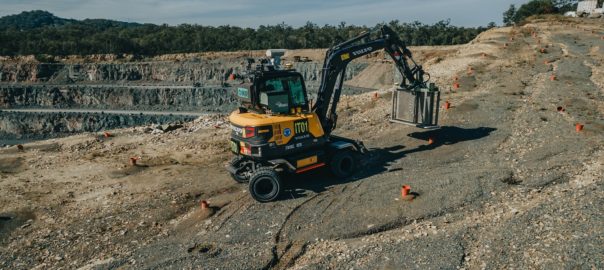IM’s Teams call with Olitek Mining Robotics’ (OMR) James Oliver and Newcrest’s Tony Sprague starts like many other meetings, with a safety share.
Centred on the experiences of a drill and blast expert, Barry Crowdey, owner of Blastcon Australia Pty Ltd, this ‘share’ goes some way to highlighting mining’s hidden safety problem.
“So often we hear about safety shares that are almost instantaneous: rock failures, rock bursts, collapses, vehicle incidents, energy releases, ground collapses, or somebody getting pinned against something,” Oliver, OMR’s Managing Director, told IM. “You have this instantaneous safety hazard you are always trying to protect against.
“The ones that don’t get reported – and are possibly creating a big stigma in the mining industry – is the ongoing wear and tear on the human body.”
Crowdey, a blasting consultant, offers direct experience here.
As a charge-up operator, he was recently side-lined for six months after major shoulder surgery. A whole host of repetitive tasks – such as push and pull activities during blasthole preparation and charge-up – conducted over the last two decades had proven too much for his body.
“A charge-up operator is a highly sought-after job,” Oliver said. “The perception is: you have to be tough to do it well. Barry never complained about this – which probably speaks to awareness around men’s mental health to a degree – and would often use his time off to recover from body soreness likely caused by these repetitive tasks.”
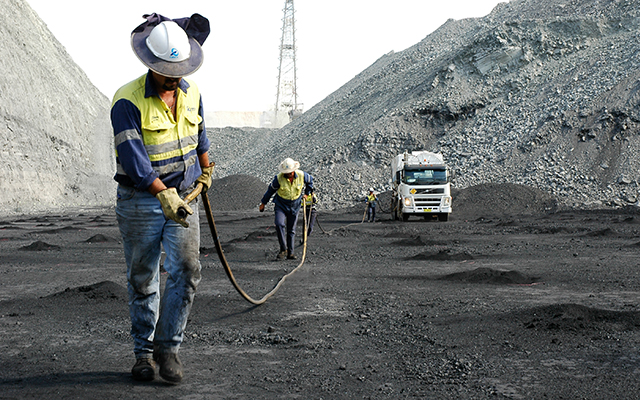
He added: “After stories like this, it is no wonder the mining industry has a stigma for wearing people out and, essentially, taking away more than it is providing – personally and from an environmental perspective.”
Sprague, Group Manager, Directional Studies and Innovation at Newcrest, has experienced some of the strains placed on the human body by carrying out similar manual tasks on mine sites, reflecting on a three-month stint on a blast crew in Kalgoorlie at the height of summer.
He, Newcrest and the wider mining industry are responding to these issues.
For the past three-or-so-years, Newcrest has been collaborating closely with OMR to develop a range of smart, safe and robust robotic systems enabling open-pit mechanised charge-up, blasthole measurement and geological blasthole sampling, as well as underground remote charge-up for tunnel development.
This suite of solutions is tackling a major industry problem that most mining OEMs focused on automating load and haul, or drilling operations, are not looking at.
OMR is addressing this market gap.
“Apart from a small number of mines and in specific applications, the mining industry is generally not ready for automation,” Oliver said. “Effective mechanisation of the hazardous mining tasks is what is needed first. This is where design thinking is crucial – process review, deletion, modification and optimisation to enable robotic mechanisation.”
Sprague added: “Most processes in mining have been designed for fingers and have taken hundreds of years to be optimised around them. We now need to mechanise these processes before we can start thinking about automating.”
The metric for momentum
The injuries that OMR and many others are looking to alleviate with mechanisation of these manual processes are not generally captured by lost time injuries or other similar safety metrics.
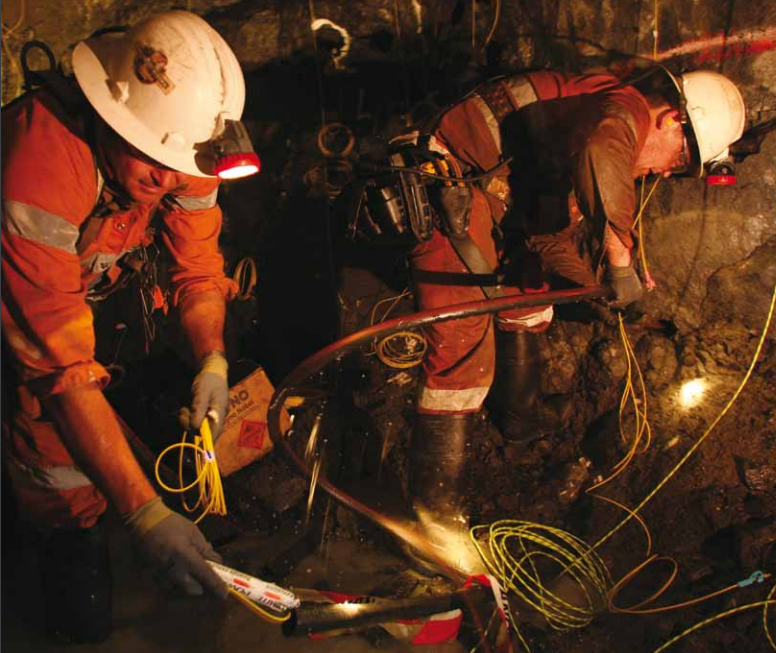
This has historically made it hard to invest in such technology – the numbers don’t typically show up in the WH&S reporting.
Yet, the risk of not confronting this issue is starting to have more sway over operational decision making at the same time as technology is reaching a suitably mature level.
“The image of Barry at home recovering from surgery to address career-induced injuries is not the image the mining industry wants to portray any longer,” Oliver said.
And with mining companies competing with other industries for skilled talent, they can no longer afford to put such stress on their people.
The idea, as OMR says, is to maintain process performance with well executed mechanised equipment. “Strain the machinery, not the people” is one of the company’s mottos.
And it will only take a few more frontrunners adopting such technology to affect real change across the industry, according to Oliver.
“Socially, people will speak,” he said. “If the mine down the road has someone in the comfort of an air-conditioned cabin carrying out remote charge-up operations, that news will soon spread. Operators will no longer tolerate being exposed to rock bursts, injuries and the like, and will leave positions where they are put in such a situation.”
It is such momentum that has, arguably, led to the industry backing innovators like OMR.
One of the company’s products, the Remote Charge-up Unit (RCU), is now the subject of a major collaborative project managed by the Canada Mining Innovation Council (CMIC).
Seeking to alleviate the issues associated with loading and priming explosives at the development face, the RCU’s core enabling technology is OMR’s innovative “Trigger Assembly” (pictured below), which enables lower cost conventional detonators to be mechanically installed safely and efficiently. This system is fitted to a modified Volvo wheeled excavator, with its hydraulic robotic boom, and is the key to moving people away from harm’s way in the underground mining setting.
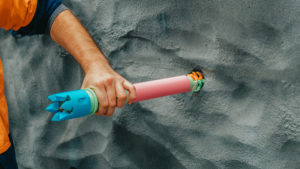
The project is being delivered in a series of development phases through to Technology Readiness Level 7. This functioning prototype machine will enable personnel to move at least 4-5 m away from the underground development face and carry out efficient and effective face charge-up.
This project is moving into the procurement and build phase of the first prototype, according to Oliver.
Newcrest is also one of the major miners steering developments of the RCU, alongside Agnico Eagle, Glencore and Vale within the CMIC collaboration.
While Sprague says his company has injected early seed funding to get some of the OMR work moving, he thinks industry collaboration is key to bringing the products to market.
“What got me into wanting to do these sorts of projects is the belief that the mining industry can be so much better than it currently is,” Sprague said. “We can change this faster by finding smart, agile companies like Olitek and support them with groups of like-minded mining companies to accelerate projects. We are showing that when the industry works together, we can make solutions to our problems appear.
He added: “I’m a true believer that momentum breeds momentum. In these types of projects, I use my finite seed funds and stretch them as far as possible. I might not know how to get to the end of a project in terms of funding it, but if I can get it to a point where we have some TRL3 designs and lab testing to prove the concept, you can go out to the market and find ways to progress up through the technology readiness levels.
“It is about chipping away and progressing up through the TRLs as opposed to asking the industry to blindly invest in R&D.”
Moving up a level
And this is where most of OMR’s technology suite is at: TR5 to TRL6 level.
Oliver explained: “If we look at the RCU unit at the moment, we have a robotic excavator platform that was developed on a sister project. This modular approach we are taking has allowed us to go into new applications seamlessly because of the base technology building blocks we have created.”
Alongside the RCU, the company is working on an “Anako” suite of products, namely: Anako Sense, Anako Sample and Anako Prime.
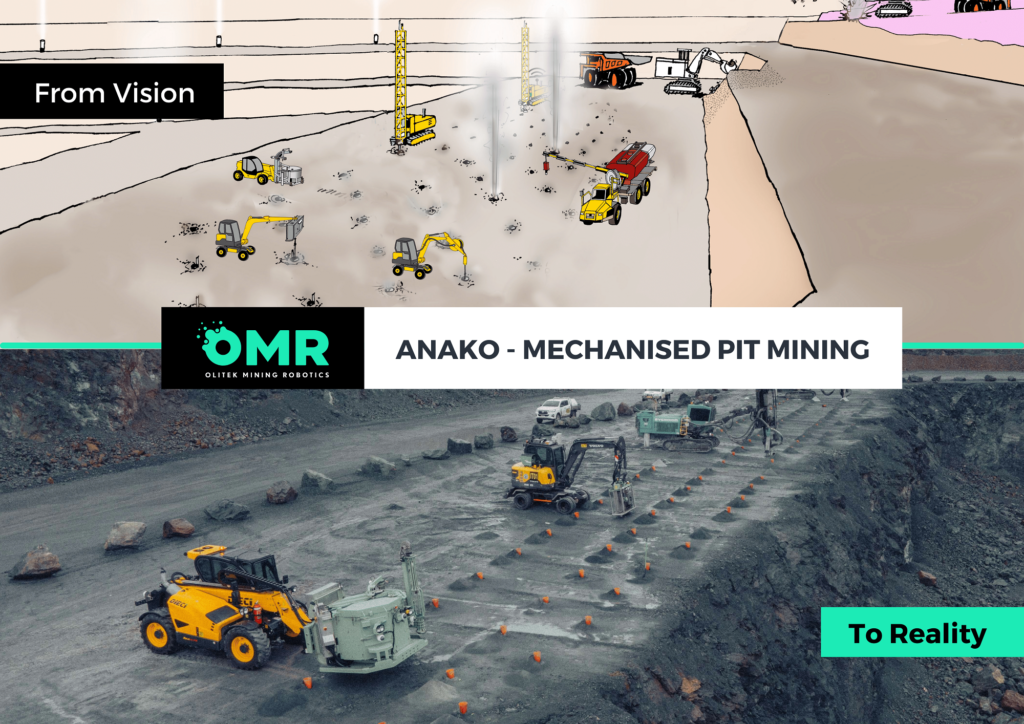
Anako Sense is a borehole probe sensing machine allowing operators to remotely measure the depth, temperature and presence of water within blastholes. It has been designed to mechanise this quality monitoring process in the open pit, removing operators from danger and putting them in the safety of an air-conditioned cabin. The Mark 2 machine – which is now commercially available – provides faster than manual cycle times, while eliminating fatigue, repetitive strain injury and exposure risks, according to OMR. It also provides real-time data capture of borehole quality measurements.
Anako Sample provides a mechanised sampling process to collect blasthole data. It, again, removes personnel from harm’s way, while providing fast cycle times and repeatable sample quality. It also provides automated data recording. This technology is currently going through Factory Acceptance Testing, with plans to deploy to a customer site shortly.
Anako Prime – for mechanised open-pit charge-up – provides all the benefits of the other Anako products while being compatible with multiple types of explosives. It is leveraging the developments made in the underground environment with the RCU and has a Mark 1 machine completed. Progress is also being made on a Mark 2 version to achieve high productivity, fully mechanised priming and bulk emulsion placement, according to Oliver.
While more products could be added to the OMR portfolio in time, the company is focused on leveraging the proven Volvo wheeled and excavator platform that can scale up from 6 t to 60 t capacities and can move quickly around the mine.
Given the strong collaborative relationship OMR has fostered with Volvo over the years, there is also potential down the line for the Volvo network to support these machines across the globe, providing the machine uptime safety net that many remote mine operators would like if they were to take up the OMR technology option.
The inspiration
Crowdey’s role in this story does not end with the safety share. He is also now training operators on this new equipment, providing a real-life example of the reason to adopt such mechanisation as well as how easy that adoption process is.
Sprague said: “You might think you need to be an expert excavator operator to work these technologies, yet the smart controls, vision and positioning systems for hole location, for instance, means the machines do the hard work for you.”
Oliver added to this: “We say a trainable operator can be sat in that machine and, after a matter of days, be as efficient as a manual operator.”
There is an impending deadline for mine operators to confront these issues, with mechanisation of the most dangerous processes the first port of call, according to Oliver.
“The only way to stop this mining impact is about enabling machinery to do the work and going through a mechanisation process to ensure the Barrys of this world don’t have to conduct these manual processes,” he said. “A good example of that over the last decade is the installation of hose feeders on emulsion pumping units in blasthole charging. That represents a ‘step’ in the right direction, but what we need now is ‘step change’.
“Eventually there will be places in a mine that people simply cannot go, so we better start perfecting mechanisation now as automation will be needed one day. It might be 10 years from now, but, if we’re not mechanised by that point, we will simply not be able to mine these more challenging ore deposits.”







